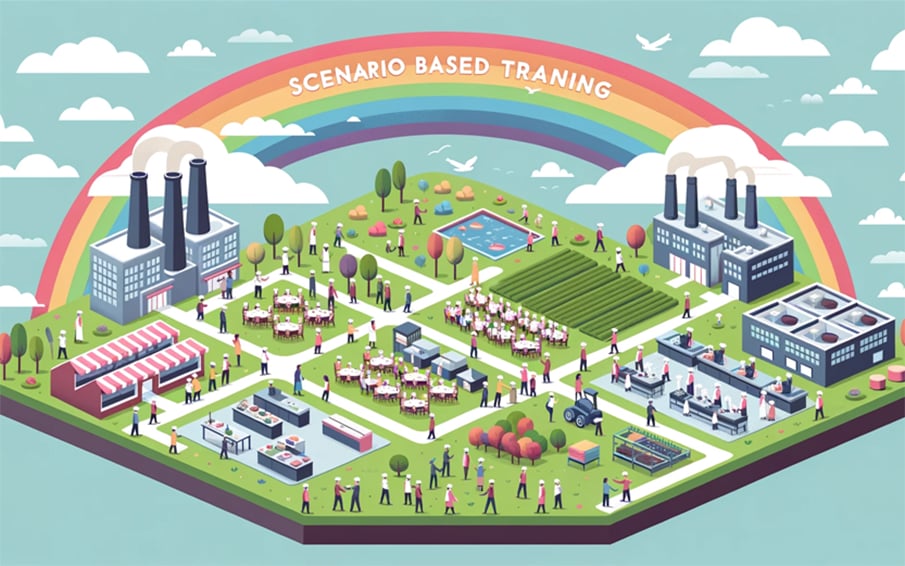Ever been thrown into a make-believe situation, a hypothetical setting, or a simulated environment to learn a new skill or concept? If yes, then you’ve tasted the beauty of scenario based training. Think of it as a virtual reality game, but instead of chasing dragons or collecting coins, you’re acquiring real-world skills and knowledge. Dive in as we unpack this incredibly engaging teaching method.

Delving into Scenario Based Training
In the vast ocean of training methods, scenario based training shines as a beacon for those yearning for hands-on, practical learning experiences. While traditional lectures and slide shows might give you the theory, scenario based training plunges you straight into the deep end, letting you swim in real-world situations. Why read about swimming when you can jump into the water, right? This method is all about getting your feet wet (metaphorically, of course). Let’s explore why this approach is gaining traction in diverse fields, from medicine to corporate training.
The Essence of Scenario Based Training
At its core, scenario based training places learners in a realistic or hypothetical situation related to their field or study. This immersive approach demands active participation and decision-making, ensuring the learner is fully engaged and obtaining first-hand experience. Imagine it as rehearsing for a play; by being in the character’s shoes, you naturally gain a deeper understanding.
Benefits of Scenario Based Training
Benefits of scenario based training are includes some:
- Real-world Application: One of the standout advantages is its emphasis on real-world application. It’s like test-driving a car before you buy it. You get a feel for real-life challenges and situations.
- Engagement Boost: The participative nature of this method ensures learners are actively involved. Remember those classes where the teacher droned on, and you zoned out? Scenario based training is the exact opposite.
- Mistake-friendly Environment: It’s a safe space. You can make mistakes, learn from them, and retry without real-world consequences. It’s like playing a video game level repeatedly until you get it right.
Limitations to Consider
While scenario based training offers numerous benefits, it’s essential to acknowledge its limitations. Not all topics lend themselves to this format, and designing realistic scenarios can be resource-intensive. Moreover, without proper facilitation, learners can sometimes miss the intended lessons.
Diving Deeper: Scenario Based Training Examples
Medical Training
Ever heard of medical students practicing surgeries on dummies or using VR to simulate a surgery? That’s scenario based training examples at its finest. Here, the stakes are high – a wrong move can mean life or death in the real world. By training in such an environment, medical students get a genuine feel for their tasks without the risk.
Flight Simulation
For pilots, the first flight shouldn’t be with real passengers. Flight simulators are perfect scenario based training examples. They emulate potential challenges like turbulent weather, ensuring pilots can handle any situation they might encounter.
Corporate Conflict Resolution
Imagine you’re in a workshop, and you’re handed a script. Your role? A manager mediating between two conflicting colleagues. This is an example of what is scenario based training in the corporate world. It enables professionals to handle real-life workplace situations effectively.
Incorporating Scenario Based Training into Your Curriculum
Understand Your Audience
Before diving into scenario based training, grasp who your learners are. What are their needs? Preferences? Challenges? By understanding this, you can craft scenarios that resonate with them.
Design Realistic Scenarios
Ever watched a movie and thought, “That would never happen in real life!”? Avoid that. Your scenarios should mirror real-life situations to be effective. This ensures that the learning is directly transferable.
Facilitate, Don’t Dictate
As an instructor, your role shifts from being a lecturer to a facilitator. Guide the discussion, ask probing questions, and provide feedback. But remember, the scenario is the star of the show. Let learners explore and understand on their own terms.
Evaluate and Iterate
Post-training, gather feedback. Were the scenarios realistic? Did the learners find value? Use this feedback to iterate and improve future sessions.
Wrapping Up
So, what is scenario based training? It’s more than just a teaching method. It’s an experience, a deep dive into real-world challenges without the associated risks. By practicing in a controlled environment, learners can make mistakes, learn, and emerge better prepared for real-life situations.
Remember when we compared it to a video game? In essence, it’s a ‘game’ where skills are your ‘power-ups’, and knowledge is your ‘armor’. Ready to level up?


